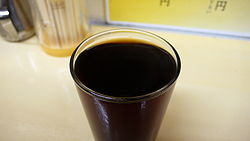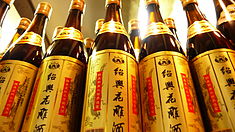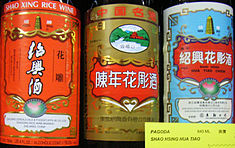- Huangjiu
-
"Yellow wine" redirects here. For the French wine made in the Jura region, see Vin jaune.
Huangjiu 
A glass of Shaoxing wine, a variety of huangjiu Traditional Chinese 黃酒 Simplified Chinese 黄酒 Hanyu Pinyin huáng jiǔ Literal meaning yellow wine Transcriptions Mandarin - Hanyu Pinyin huáng jiǔ Min - Hokkien POJ hông-chiú Huangjiu (黃酒, literally "yellow" wine, liquor or alcohol) is a type of Chinese beverage brewed directly from grains such as rice, millet, or wheat. Unlike baijiu, such liquors are not distilled, and contain less than 20% alcohol, due to the inhibition of fermentation by ethanol at that concentration. These wines are traditionally pasteurized, aged, and filtered before their final bottling for sale to consumers. The various styles of huangjiu may vary in color from clear to beige, yellowish-brown, or reddish-brown.
Huangjiu is either drunk directly after being cooled or warmed, or used in Chinese cooking. Major producers of huangjiu include mainland China and Taiwan.
Contents
Classifications
Chinese "yellow liquors" (fermented wines) are classified based on several factors. Among them are the liquor's dryness, the starter used in its production, and its production method.
Dryness/Sweetness
This is the formal classification for all Chinese wines. There are five categories: dry, semi-dry, semi-sweet, sweet, and extra-sweet.[1]
- Dry (Gan, 乾, 干): with sugar content no greater than 1%. This type of yellow wine has the lowest fermentation temperature. An example of this kind is Yuanhongjiu (元红酒, literally "Champion's Red Wine"), a specialty of Shaoxing, so-named because traditionally the wine jars are painted red.
- Semi-dry (Ban Gan, 半乾, 半干): with sugar content between 1% and 3%. This type of huangjiu can be stored for a long period of time and encompasses most of the varieties of huangjiu that are exported from China. An example of this variety is Jiafanjiu (加饭酒, literally "Added Rice Wine"), a variation on the Yuanhongjiu that involves adding more rice in fermentation. The jiafanjiu is traditionally used for ceremonies, such as child birth, engagement, and funerals.
- Semi-sweet (Ban Tian, 半甜): with sugar content between 3% and 10%. The longer the semi-sweet huangjiu is stored, the darker its color becomes. This variety of huangjiu cannot be stored for long periods of time. An example of this kind is Shanniangjiu (善酿酒, literally "Best Made Wine"), a specialty of Shaoxing which partly uses vintage Yuanhongjiu instead of water.
- Sweet (Tian, 甜): with sugar content between 10% and 20%. An example of this variety is Feng Gang Jiu (封缸酒, literally "Conceal Earth Jar Wine"). In comparison to previous types of huangjiu, sweet huangjiu can be manufactured all year round when using traditional production methods.
- Extra-sweet (Nong Tian, 浓甜): with sugar content equal or greater than 20%. An example of this variety is Xiang Xue Jiu (香雪酒, literally "Fragrant Snow Wine").
Starter/Inoculant
- Small starter (小麴, 小曲; pinyin: xiǎo qū): Wines inoculated using rice cultured with Rhizopus, yeast, and other microorganisms. The mixture generates less heat, so they are mostly used in the tropical South of China.
- Large starter (酒麴, 酒曲; pinyin: jiǔ qū): Wines inoculated using rice cultured with Aspergillus oryzae and yeast. Almost all popular alcoholic drinks in China belong to this type.
- Red starter (紅麴, 红曲; pinyin: hóng qū): Wines that are flavoured and coloured with Monascus purpureus or other red rice molds of the Monascus genus.
Production methods
- Hot rice (燙飯; pinyin: tàng fàn): The steamed rice used to make the wine is cooled in the open air until it is still relatively warm before processing.
- Cool rice (凉飯; pinyin: liáng fàn): The steamed rice used to make the wine is quenched with cold water before further processing. The unfiltered mash for this wine is sometimes eaten as a dessert or used as an inoculant for other Chinese wines.
- Feeding rice (加飯 or 餵飯; pinyin: jiā fàn or wèi fàn): Steamed rice is continuously fed into a fermenting mixture (up to three times), which produces a sweeter wine.
- Fortified: Distilled Chinese wines are added to the fermenting mash, which increases the concentration of alcohol in the mash and halts the fermentation process. This leaves a significant quantity of unfermented sugars, thus producing an especially sweet tasting wine.
Types
Some of the most popular yellow liquors include:
- Mijiu (米酒; pinyin: mǐjiǔ) is the generic name for Chinese fermented rice wine, similar to Japanese sake. It is generally clear, and is used for both drinking and cooking. Mijiu intended for cooking often contains 1.5% salt. Alcohol content by volume: 12-19.5%.
- Fujian glutinous rice wine (福建糯米酒; pinyin: Fújiàn nuòmǐ jiǔ): made by adding a long list of expensive Chinese medicinal herbs to glutinous rice and a low alcohol distilled rice wine. The unique brewing technique uses another wine as raw material, instead of starting with water. The wine has an orange-red color. Alcohol content by volume: 18%.[2]
- Huadiao jiu (花雕酒; pinyin: huādiāo jiǔ; lit. "flowery carving wine"), also known as nu'er hong (女儿红; pinyin: nǚ'ér hóng, lit. "daughter red"): a variety of huangjiu that originates from Shaoxing, in the eastern coastal province of Zhejiang. It is made of glutinous rice and wheat. This wine evolved from the Shaoxing tradition of burying nu'er hong underground when a daughter was born, and digging it up for the wedding banquet when the daughter was to be married. The containers would be decorated with bright colors as a wedding gift. To make the gift more appealing, people began to use pottery with flowery carvings and patterns. Huadiao jiu's alcohol content is 16% by volume.
- Shaoxing wine (绍兴酒 or 紹興酒; pinyin: Shàoxīng jiǔ) is the more internationally known high grade version. It is commonly used in Chinese cooking as well as for drinking. The reddish color of these wines is imparted by red yeast rice. One prominent producer of Shaoxing wine is Zhejiang Gu Yue Long Shan Shaoxing Wine Co., Ltd. (古越龍山) of Shaoxing, Zhejiang.[3] It is not uncommon for some varieties of Shaoxing wine to be aged for 50 years or more.[4]
- Hong lu jiu (红露酒 or 紅露酒; pinyin: hóng lù jiǔ; lit. "red wine")photo are basically made of the same wine except they are of lower grade than Shaoxing wine. It is named differently depending on the age, the container, and how they are used.
- Liaojiu (料酒; pinyin: liàojiǔ; lit. "ingredient wine")photo is a lower grade of huangjiu widely used in Chinese cuisine as a cooking wine. Often it is sold with various seasonings added, such as cloves, star anise, cassia, black cardamom, Sichuan pepper, ginger, nutmeg, and salt.
See also
- Choujiu
- Baijiu
- Chinese wine
- Chinese grape wine
References
External links
 Chinese alcoholic beverages
Chinese alcoholic beveragesBeverages Baijiu • Beijing Beer • Canton (liqueur) • Choujiu • Er guo tou • Gouqi jiu • Huangjiu • Kaoliang • Luzhou Laojiao • Maotai • Mijiu • Rice baijiu • Shaoxing wine • Tibetan beer • Wuliangye Yibin • Xifeng jiuIndustry CR Snow • Guangzhou Zhujiang Brewery Group • Tsingtao Brewery • Beijing Yanjing Brewery • Harbin Brewery • Kingway Brewery • Hangzhou Qiandaohu Beer Co., Ltd. • San Miguel Brewery Hong Kong (serving Hainan)Categories:- Fermented beverages
- Chinese alcoholic beverages
- Rice drinks
- Types of beer
- Chinese wine
Wikimedia Foundation. 2010.





